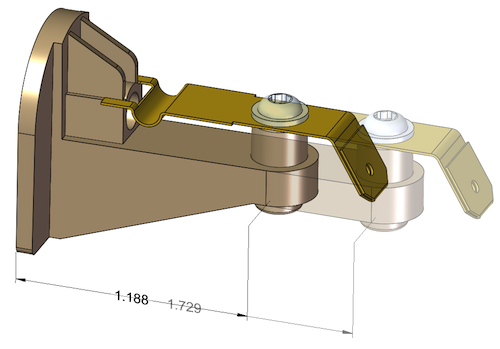December 21, 2012
For those who think Siemens PLM Software’s talk about openness is just talk, it pays to consider its latest announcements, that while seemingly unrelated, seem to go a long way in underscoring its commitment to the much discussed strategy.
In the course of a week, the PLM veteran announced that its 15-year old JT data format has been accepted as what it claims is the first ISO international standard for viewing and sharing lightweight 3D product information. In a separate release, Siemens PLM Software announced 3DSync, a CAD editing tool based on Synchronous Technology, which it plans to offer to any CAD user—not just those working with NX and SolidEdge—as a way to increase productivity when dealing with imported CAD models from heterogeneous systems.
While on the face of it, 3DSync and the JT standard address very different needs, they both play a role in helping organizations work more efficiently and collaborate more effectively when using different CAD systems. Heterogeneous CAD is a reality today given the predominance of global design chains made up of partners and suppliers, each comfortably entrenched in their own portfolio of preferred tools. CAD interoperability and the ability to modify 3D models created in another system has been a longstanding pain point for customers across industries, particularly those with complex and large supply chains
“Clearly JT and Parasolid and collaboration is part of our base story and while it’s serendipitous that the announcements happened in the same day, it’s a proof point of a strategy we’ve been pursuing for years around multi-CAD environments and openness,” says Bill Boswell, senior director of partner strategy for Siemens PLM Software.
JT, which many CAD vendors support and which has long served as a de facto open format for sharing and visualizing 3D product data across PLM systems in companies like General Motors, has now been adopted by the ISO as an international standard. Siemens PLM Software worked closely with ProSTEP iViP, a global consortium committed to advancing open standards, to complete the process of winning ISO acceptance for JT as well as in publishing a key reference document. (ISO PAS 14306)
Instead of continually having to clean up and rework native CAD models for sharing with engineering peers, JT provides a lightweight description of a design, including details like geometry, manufacturing information, and meta data, but without the full design intent. Even though the spec was published in 2007 as an open format, the ISO blessing removes any lingering industry concerns that Siemens PLM Software might pull back on its commitment to open standards, according to Mike Zink, the company’s senior product manager and openness evangelist.
“Official ISO support for JT does not impact the technology or the capabilities of JT per se, but it does silence the naysayers who wanted to believe that Siemens could at any time wrest back JT and retake full control for their own purposes,” agrees Ken Versprille, executive consultant at CIMdata. “Companies can now feel safe in adopting JT and be assured that it can and will be supported in the future, whether by Siemens or others.
While lots of CAD and design tool companies support JT, there are other options being promoted around multi-CAD data exchange. The 3D PDF Consortium is promoting 3D PDF for 3D model exchange, while Siemens’ competitor Dassault Systemes has its own format, 3D XML, which is positioned as a universal lightweight XML-based format for quick and easy sharing of 3D data.
While Dassault prefers its own 3D XML over JT, it does support JT in a number of its products, according to Fabien Fedida, Dassault’s senior director, global offer strategy. However, Fedida says the ISO announcement supports JT as a visualization standard, not as a format for data exchange, thus it advises customers to continue to invest in STEP as a broader CAD interoperability standard.
“We’ve long recommended customers leverage STEP as the ultimate solution for 3D visualization and interoperability,” Fedida says. “STEP is just the better way to go when you consider the bigger picture. It handles visualization, interoperability, and archiving. On the archiving front, this is mandated for aerospace companies, so… using STEP kills several birds with one stone, more efficiently, and more cost effectively.”
The other piece of the latest Siemens “openness” push is 3DSync, a new application designed to simplify the process of importing and modifying 3D data from multiple sources. The software is architected on Synchronous Technology, a key capability in NX and SolidEdge. The idea for 3DSync was rooted in feedback from customers, who continually cited the ability to easily work with imported CAD models as one of the core benefits of Synchronous Technology, according to John Fox, Siemens’ vice president of marketing, mainstream engineering. In fact, based on industry research, Siemens found that 44% of imported CAD models had to be reworked due to translation errors during the import stage.
“There’s always been a lot of complaints that once you import something, it becomes a dumb solid, but it’s not like the solid is dumb, it’s more that the CAD system is dumb,” Fox explains. Given Synchronous Technology’s ability to increase productivity when working with imported CAD data by a factor of 10 or more, the company saw opportunity to parlay this strength to a broader market, Fox says.
3DSync will be available for testing at no charge through May 15, 2013. You can watch a video of how it works below.
Subscribe to our FREE magazine, FREE email newsletters or both!
About the Author
Beth Stackpole is a contributing editor to Digital Engineering. Send e-mail about this article to [email protected].
Follow DE







